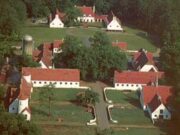When Martha Berry established her Boys’ Industrial School in 1902 on eighty-three acres of land given to her by her father, little did she dream of the recognition she would receive for her agricultural efforts. In September 2002 the Agricultural Hall of Fame at the University of Georgia inducted Martha Berry posthumously for her contribution in agriculture to the state. Having seen the poor level of productivity on the farms and the poverty that prevailed in the Appalachian foothills surrounding her home at Oak Hill near Rome, she vowed to help these rural families by teaching the boys whom she could entice to come to her school improved farm methods and ways of achieving greater productivity on the land. Berry went about the business of teaching them not only the basic academic subjects but also the skills to clear land, erect buildings, establish gardens and crops, and perform other farm tasks that would support her institution. Berry’s mission of educating the head, the heart, and the hands of her students prevails today at Berry College, now a comprehensive liberal-arts college.
Early Development
Although no formal courses were taught in agriculture the first few years, students at the Boys’ Industrial School received instruction in proper farm methods in their work under skilled supervisors. They grew a variety of fruits and vegetables, including corn, beans, tomatoes, potatoes, sweet potatoes, strawberries, apples, and peaches, as well as sorghum cane and grain. What the students, faculty, and staff did not eat in the summer, they canned for winter consumption. Livestock on the farm included a dairy herd, driving stock, sheep, pigs, goats, and chickens. The institution became almost self-sufficient by design.
Beginning in 1908 Berry offered annual summer institutes for farmers of the area in cooperation with the Georgia State College of Agriculture. These institutes featured lectures, discussions, and demonstrations of improved methods of agriculture and extended the school’s efforts to improve conditions in the rural sections. Farmers learned of the importance of good drainage for their farmlands and of crops that had received little attention in the area.
Within a decade of the school’s founding, an up-to-date dairy barn with silo had been erected, as had a cannery with a modern steam plant, and the school domain included about 2,000 acres. By 1924 the school owned 6,000 acres with 1,000 acres under cultivation, 500 acres in pastures, and most of the remainder in woodlands. A tract of about 375 acres was broken into model farms of 40 to 50 acres each, on which graduates and former students of the school were settled. Operators of the model farms were paid a small cash salary and given one-third of their crops, and the farms were equipped by the school. The school also provided two-thirds of all seeds and fertilizers. The goal was to develop real object lessons in practical farming and demonstrations of what Berry graduates could do.
Winning prizes at the county fair on its stock and other farm products was a regular occurrence for Berry over the years, but the goal was to help the fair along, not to compete with neighboring farmers. Berry’s Jersey dairy herd, the center of all agricultural operations at the institution, produced champion cattle over the years, as did other projects. For example, in 1926 the Berry herd won 150 prizes at six fairs, including 3 grand champion, 2 senior champion, 3 junior champion, and 52 first-prize awards. More recently, prize cow Sooner Sapphire was a contestant for the Cow of the Century title in the Great Cow Contest. Now retired from the Berry herd of regularly milked cows, Sapphire’s superior genes are being passed along to her offspring through embryo transfer.
Over the years Berry’s agriculture majors have gained ready acceptance into various agriculture careers or notable graduate and veterinary medicine schools. Approximately 90 percent of applicants receive admission to such veterinary schools as Auburn University, Cornell University, and the Universities of Florida, Georgia, and Tennessee.
Agriculture Curriculum
By the end of the school’s first decade, courses offered for boys included general agriculture, animal husbandry, soils, farm management, and agronomy. The Martha Berry School for Girls was established in 1909, and soon three courses in agriculture were being offered for the girls: simple agriculture (practical work on campus and in gardens); advanced agriculture (work in hothouses and greenhouses); and dairy and poultry.
The schools grew into a junior college in the 1920s and a senior college in the early 1930s. The college began to offer a Bachelor of Science in Agriculture degree with majors in general agriculture, agronomy, animal husbandry, dairy husbandry, horticulture, poultry husbandry, and vocational agriculture. All bachelor’s-degree agriculture majors were discontinued by 1968, but a two-year program had been developed and grew into an Associate of Science degree with majors in animal, dairy, and ornamental horticulture technology.
Although these associate degree programs were discontinued in the late 1980s, a major in animal science initiated in the mid-1970s under the Bachelor of Science degree became one of the most popular majors among students. Majors in horticulture and agribusiness were established and later discontinued, but the animal science major continues in the twenty-first century as an important part of the college curriculum.
In the late 1980s and early 1990s two Berry professors led the development of a still-popular curriculum series to teach elementary and middle school students in Georgia about agriculture, the source of their food and fiber. The curriculum series continues in use.
The college domain contains about 28,000 acres, including approximately 23,000 acres in pine saw timber. Other agricultural operations include an equine center, a small dairy for teaching and research, beef and sheep herds, pastures, and the growing of hay for the animals. Agriculture continues to be an important emphasis as Berry enters its second century.




